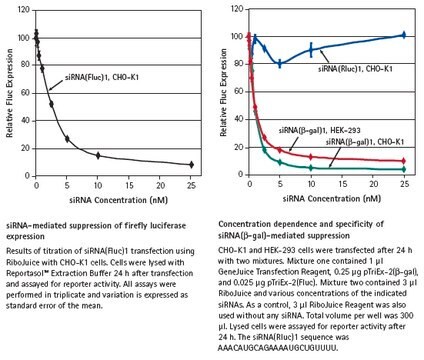S1452
MISSION® siRNA Transfection Reagent
Synonyme(s) :
MISSION® siRNA Transfection Reagent
About This Item
Produits recommandés
Gamme de produits
MISSION®
Niveau de qualité
Forme
aqueous solution
Conditions d'expédition
wet ice
Température de stockage
2-8°C
Description générale
Effective gene silencing and reduced off target effects are achieved using a low siRNA concentration (1nM). The siRNA Transfection Reagent is provided as a sterile solution, and is compatible with serum and antibiotics.
Autres remarques
Informations légales
Produit(s) apparenté(s)
Mention d'avertissement
Warning
Mentions de danger
Conseils de prudence
Classification des risques
Flam. Liq. 3
Code de la classe de stockage
3 - Flammable liquids
Classe de danger pour l'eau (WGK)
WGK 3
Point d'éclair (°F)
120.2 °F
Point d'éclair (°C)
49 °C
Certificats d'analyse (COA)
Recherchez un Certificats d'analyse (COA) en saisissant le numéro de lot du produit. Les numéros de lot figurent sur l'étiquette du produit après les mots "Lot" ou "Batch".
Déjà en possession de ce produit ?
Retrouvez la documentation relative aux produits que vous avez récemment achetés dans la Bibliothèque de documents.
Les clients ont également consulté
Articles
This brief webinar provides an overview of what transfection is and the methods that are used to introduce DNA or RNA into eukaryotic cells.
Contenu apparenté
Sigma-Aldrich® Advanced Genomics is the leading provider of gene editing and silencing technologies including CRISPR, Cas9, synthetic guide RNA (sgRNA), and Zinc Finger Nuclease (ZFN).
Notre équipe de scientifiques dispose d'une expérience dans tous les secteurs de la recherche, notamment en sciences de la vie, science des matériaux, synthèse chimique, chromatographie, analyse et dans de nombreux autres domaines..
Contacter notre Service technique











